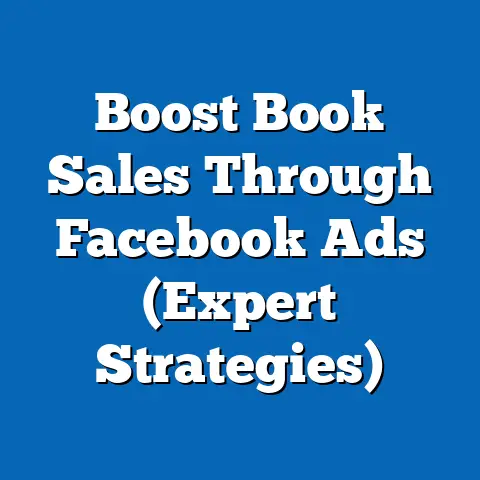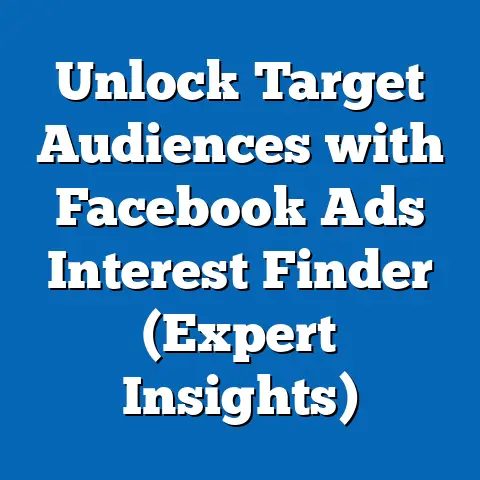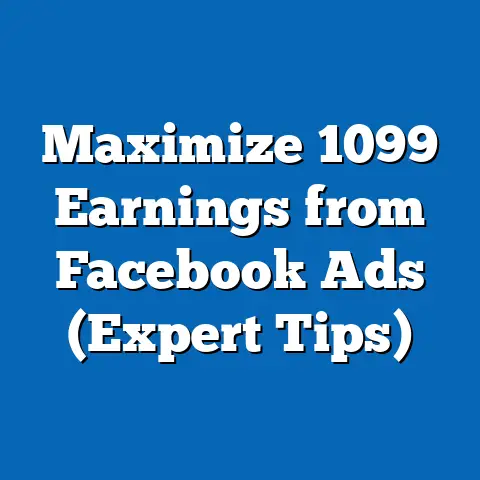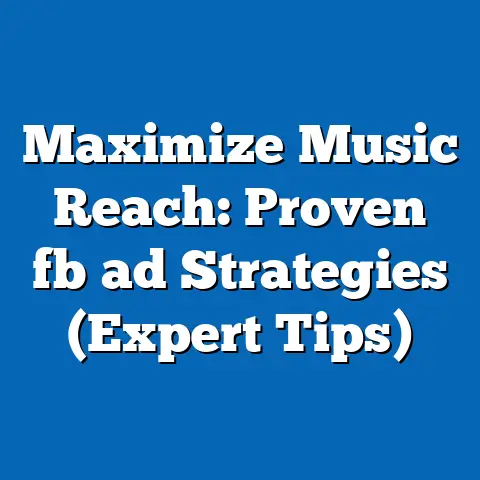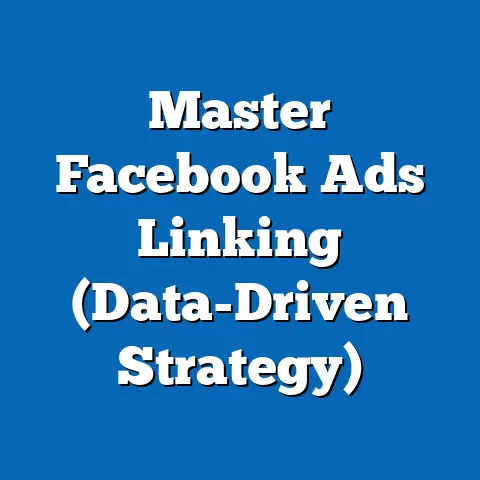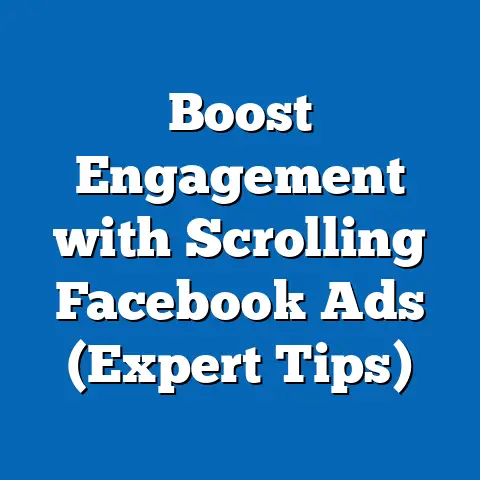Unlock Facebook Ad Revenue 2025 (Proven Strategies Inside)
The world of digital advertising is constantly evolving, like a living, breathing organism. What worked yesterday might be obsolete tomorrow. I remember back in 2010, simply having a Facebook Page was enough to generate buzz and attract customers. Now, it’s a sophisticated ecosystem driven by algorithms, data analytics, and cutting-edge technology. Innovation is no longer a luxury; it’s a necessity for survival and, more importantly, for maximizing ad revenue.
Over the years, I’ve witnessed firsthand how platforms like Facebook have transformed the way businesses connect with their audiences. The integration of AI, machine learning, and advanced data analytics has revolutionized targeting, personalization, and campaign optimization. It’s not just about placing an ad anymore; it’s about delivering the right message, to the right person, at the right time.
Consumer behavior is also in a constant state of flux. People are more discerning, more demanding, and have shorter attention spans than ever before. Facebook has responded by introducing innovative ad formats, enhanced targeting capabilities, and a greater emphasis on user experience.
Understanding the Current Landscape of Facebook Advertising
As we approach the end of 2023, it’s crucial to take stock of the current state of Facebook advertising. The platform has undergone significant changes in recent years, and understanding these shifts is paramount to developing effective strategies.
One of the most notable changes has been the evolution of Facebook’s advertising policies and algorithms. In response to privacy concerns and regulatory pressures, Facebook has implemented stricter guidelines regarding data collection and targeting. This has forced advertisers to become more creative and rely on ethically sourced data.
User demographics and engagement patterns have also shifted. While Facebook remains the dominant social media platform globally, it faces increasing competition from newer platforms like TikTok and Instagram (which, ironically, is owned by Meta, Facebook’s parent company). Understanding where your target audience spends their time and attention is crucial for allocating your advertising budget effectively.
Speaking of competition, the digital advertising space is more crowded than ever. Facebook competes not only with other social media platforms but also with search engines like Google and niche advertising networks. Each platform has its strengths and weaknesses, and it’s essential to choose the right one based on your specific business goals and target audience. I’ve found that a multi-channel approach, where you leverage the unique capabilities of different platforms, often yields the best results.
Finally, it’s essential to understand the customer journey and where Facebook fits into that journey for advertisers. Are you using Facebook to generate awareness, drive leads, or close sales? The answer to this question will dictate your advertising strategy and the types of ads you create. For example, if you’re targeting users who are already familiar with your brand, you might focus on retargeting campaigns that showcase specific products or services. On the other hand, if you’re trying to reach a new audience, you might focus on awareness campaigns that highlight your brand’s values and mission.
Key Takeaway: The Facebook advertising landscape is constantly evolving. Staying informed about changes to policies, algorithms, user demographics, and the competitive landscape is essential for success. Understanding the customer journey and how Facebook fits into that journey is also crucial for developing effective advertising strategies.
Proven Strategies for Maximizing Facebook Ad Revenue
Now, let’s dive into the heart of the matter: proven strategies for maximizing Facebook ad revenue. These strategies are based on my own experiences, industry best practices, and data-driven insights.
Targeting the Right Audience
Targeting is the foundation of any successful Facebook advertising campaign. If you’re not reaching the right people, your ads will fall on deaf ears, no matter how compelling your creative or how attractive your offer.
Facebook offers a wide range of targeting options, allowing you to segment your audience based on demographics, interests, behaviors, and more. However, simply selecting a few broad categories is rarely enough. To truly maximize your ad revenue, you need to leverage advanced audience segmentation strategies.
Lookalike Audiences: These audiences are created by identifying users who share similar characteristics with your existing customers. Facebook analyzes your customer data (e.g., email lists, website visitors) and finds users who are likely to be interested in your products or services. I’ve found that lookalike audiences can be incredibly effective for expanding your reach and acquiring new customers.
Custom Audiences: These audiences are created by uploading your own data to Facebook. This can include email lists, phone numbers, website visitor data, and more. Custom audiences allow you to target users who have already interacted with your brand, making them more likely to convert.
Detailed Targeting: This option allows you to target users based on a wide range of demographics, interests, and behaviors. You can target users based on their age, gender, location, education, job title, hobbies, purchase history, and more. The key is to use this option strategically and avoid overly broad targeting.
Leveraging First-Party Data: In an increasingly privacy-conscious world, first-party data (data that you collect directly from your customers) is becoming more valuable than ever. This data can be used to create custom audiences, personalize ad experiences, and improve targeting accuracy. I highly recommend investing in strategies for collecting and managing first-party data, such as email marketing, loyalty programs, and website analytics.
Example: Let’s say you’re selling organic skincare products. Instead of simply targeting women aged 25-45 who are interested in skincare, you could create a lookalike audience based on your existing customers who have purchased organic products in the past. You could also create a custom audience based on website visitors who have viewed your “organic” product pages. Finally, you could use detailed targeting to target users who are interested in organic living, natural beauty, and eco-friendly products.
Key Takeaway: Effective targeting is crucial for maximizing Facebook ad revenue. Leverage advanced audience segmentation strategies, such as lookalike audiences, custom audiences, and detailed targeting, to reach the right people. Invest in strategies for collecting and managing first-party data to improve targeting accuracy and personalize ad experiences.
Crafting Compelling Ad Creative
Even with the most precise targeting, your ads will fail if your creative is lackluster. In today’s visually driven world, it’s essential to create ads that capture attention, communicate your message effectively, and inspire action.
Visual Storytelling: People are naturally drawn to stories. Use visuals to tell a compelling story about your brand, your products, or your customers. This could involve showcasing customer testimonials, highlighting the benefits of your products, or creating a behind-the-scenes look at your business.
Successful Ad Creative Examples:
- Dollar Shave Club: Their early video ads were hilarious and memorable, effectively communicating their value proposition (high-quality razors at affordable prices). The key was their witty humor and relatable scenarios.
- Airbnb: They often feature stunning photography and videos of unique properties around the world, inspiring wanderlust and showcasing the diverse range of experiences they offer. The focus is on aspiration and the promise of adventure.
- Nike: Their ads often feature athletes overcoming challenges and achieving their goals, inspiring viewers to push their limits and embrace an active lifestyle. The emphasis is on empowerment and personal achievement.
Dissecting Effective Ad Creative:
- Clear Value Proposition: The ad clearly communicates the benefits of the product or service.
- Visually Appealing: The ad uses high-quality images or videos that capture attention.
- Compelling Copy: The ad copy is concise, persuasive, and relevant to the target audience.
- Strong Call to Action: The ad includes a clear call to action that tells users what to do next (e.g., “Shop Now,” “Learn More,” “Sign Up”).
A/B Testing: Don’t assume you know what creative will resonate with your audience. A/B testing allows you to test different versions of your ads and see which ones perform best. Test different headlines, images, videos, and calls to action. Use the data to iterate on your creative and continuously improve your results. I’ve often been surprised by which ads perform best; sometimes, the simplest changes can have the biggest impact.
Key Takeaway: Compelling ad creative is essential for capturing attention and driving conversions. Use visual storytelling, learn from successful ad examples, and dissect what makes them effective. Implement A/B testing to iterate on your creative and continuously improve your results.
Utilizing Facebook’s Advanced Ad Formats
Facebook offers a variety of ad formats, each with its strengths and weaknesses. Choosing the right format based on your business objectives and target audience is crucial for maximizing your ad revenue.
Carousel Ads: These ads allow you to showcase multiple images or videos in a single ad unit. They’re ideal for showcasing a range of products, highlighting different features of a single product, or telling a story in a sequential manner.
Video Ads: Video is one of the most engaging ad formats available. Use video ads to capture attention, communicate your message effectively, and build brand awareness. Short, attention-grabbing videos tend to perform best.
Collection Ads: These ads allow you to showcase a collection of products in a visually appealing format. They’re ideal for e-commerce businesses looking to drive sales.
Lead Ads: These ads allow you to collect leads directly from Facebook without requiring users to visit your website. They’re ideal for generating leads for sales teams or building your email list.
Instant Experience Ads: These ads provide a full-screen, immersive experience for users on mobile devices. They’re ideal for showcasing your brand story, highlighting your products, or driving engagement.
Choosing the Right Format:
- Awareness: Video ads, Instant Experience ads
- Consideration: Carousel ads, Collection ads
- Conversion: Lead ads, Dynamic ads (discussed in retargeting section)
Example: If you’re selling clothing, you might use a carousel ad to showcase different outfits or a collection ad to showcase your latest arrivals. If you’re offering a free consultation, you might use a lead ad to collect contact information from interested users.
Key Takeaway: Facebook offers a variety of ad formats, each with its strengths and weaknesses. Choose the right format based on your business objectives and target audience. Experiment with different formats to see what works best for you.
Implementing Effective Budgeting and Bidding Strategies
Budgeting and bidding are crucial aspects of Facebook advertising. If you’re not managing your budget effectively or bidding strategically, you’ll waste money and fail to maximize your ad revenue.
Daily vs. Lifetime Budgets:
- Daily Budget: This option allows you to set a daily spending limit for your ad campaign. It’s ideal for campaigns that run continuously over a long period.
- Lifetime Budget: This option allows you to set a total spending limit for your ad campaign. It’s ideal for campaigns that run for a specific period, such as a promotion or event.
Manual vs. Automatic Bidding Strategies:
- Manual Bidding: This option allows you to manually set the amount you’re willing to pay for each click or impression. It’s ideal for experienced advertisers who have a good understanding of their target audience and the competitive landscape.
- Automatic Bidding: This option allows Facebook to automatically set your bids based on your campaign objectives. It’s ideal for beginners or advertisers who want to save time and effort.
When to Use Each Bidding Strategy:
- Manual Bidding: Use this strategy when you have a clear understanding of your target audience and the value of each conversion. It allows you to control your costs and maximize your return on investment.
- Automatic Bidding: Use this strategy when you’re unsure of the optimal bid amount or when you want to optimize for a specific objective, such as conversions or app installs. Facebook’s algorithm will learn over time and adjust your bids accordingly.
Budget Optimization:
- Campaign Budget Optimization (CBO): This option allows Facebook to automatically distribute your budget across your ad sets based on performance. It’s ideal for campaigns with multiple ad sets targeting different audiences.
- Ad Set Budget Optimization (ABO): This option allows you to manually set the budget for each ad set. It’s ideal for campaigns where you want to control spending on specific audiences.
Key Takeaway: Effective budgeting and bidding are crucial for maximizing Facebook ad revenue. Understand the different budgeting options and bidding strategies available and choose the ones that best align with your campaign objectives. Consider using Campaign Budget Optimization to automatically distribute your budget across your ad sets.
Leveraging Retargeting for Increased Conversions
Retargeting is one of the most effective strategies for increasing conversions and maximizing Facebook ad revenue. It involves targeting users who have already interacted with your brand, such as website visitors, email subscribers, or social media followers.
Why Retargeting Works:
- Warm Leads: Retargeting targets users who are already familiar with your brand, making them more likely to convert.
- Reminders: It reminds users about your products or services, keeping you top of mind.
- Personalization: It allows you to personalize your ad messaging based on users’ past behavior.
Setting Up Retargeting Campaigns:
- Facebook Pixel: Install the Facebook Pixel on your website to track user behavior. This allows you to create custom audiences based on website visitors.
- Custom Audiences: Create custom audiences based on website visitors, email subscribers, or social media followers.
- Dynamic Ads: Use dynamic ads to automatically show users products they have viewed on your website.
Example: A user visits your website and views a specific pair of shoes. You can then retarget that user with an ad showing the same pair of shoes, reminding them to complete their purchase. You can even offer a discount or free shipping to incentivize them to convert.
Key Takeaway: Retargeting is a highly effective strategy for increasing conversions and maximizing Facebook ad revenue. Set up retargeting campaigns using the Facebook Pixel, custom audiences, and dynamic ads. Personalize your ad messaging based on users’ past behavior.
Analyzing and Optimizing Campaign Performance
Analyzing and optimizing your campaign performance is an ongoing process. It’s not enough to simply set up your ads and let them run. You need to continuously monitor your results, identify areas for improvement, and make adjustments to your strategy.
Key Performance Metrics:
- Reach: The number of unique users who saw your ad.
- Impressions: The number of times your ad was displayed.
- Click-Through Rate (CTR): The percentage of users who clicked on your ad.
- Cost Per Click (CPC): The average cost you paid for each click on your ad.
- Conversion Rate: The percentage of users who completed a desired action, such as making a purchase or filling out a form.
- Cost Per Acquisition (CPA): The average cost you paid for each conversion.
- Return on Ad Spend (ROAS): The amount of revenue you generated for every dollar you spent on advertising.
Interpreting Facebook Ads Manager Data:
Facebook Ads Manager provides a wealth of data about your campaign performance. Learn how to interpret this data to make informed decisions about your strategy.
- Identify Trends: Look for patterns in your data. Are certain audiences performing better than others? Are certain ad formats generating more conversions?
- Compare Results: Compare your results to industry benchmarks. Are your CTR and conversion rates above or below average?
- Identify Areas for Improvement: Look for areas where your performance is lagging. Are your costs too high? Are your conversion rates too low?
Creating a Feedback Loop:
Create a feedback loop for continuous improvement of your ad campaigns.
- Set Goals: Define clear goals for your campaigns. What do you want to achieve?
- Track Results: Monitor your results closely. How are you performing against your goals?
- Analyze Data: Analyze your data to identify areas for improvement.
- Implement Changes: Make adjustments to your strategy based on your analysis.
- Repeat: Continuously repeat this process to optimize your campaign performance.
Key Takeaway: Analyzing and optimizing your campaign performance is an ongoing process. Track key performance metrics, interpret Facebook Ads Manager data, and create a feedback loop for continuous improvement.
Future Trends in Facebook Advertising
Looking ahead to 2025, several trends are likely to shape the future of Facebook advertising. Staying ahead of these trends is crucial for maintaining a competitive edge.
Technological Advancements:
- Artificial Intelligence (AI): AI will play an increasingly important role in Facebook advertising. AI-powered algorithms will be used to automate tasks, personalize ad experiences, and optimize campaign performance.
- Machine Learning (ML): ML will be used to analyze vast amounts of data and identify patterns that humans might miss. This will allow advertisers to target their audiences more precisely and create more effective ads.
- Augmented Reality (AR) and Virtual Reality (VR): AR and VR will create new opportunities for immersive advertising experiences. Imagine trying on clothes virtually or exploring a destination before booking a trip.
Shifts in User Behavior:
- Increased Privacy Concerns: Users are becoming more concerned about their privacy and data security. Advertisers will need to be more transparent about how they collect and use data.
- Mobile-First Approach: Mobile devices will continue to dominate online activity. Advertisers will need to optimize their ads for mobile viewing.
- Shorter Attention Spans: Users have shorter attention spans than ever before. Advertisers will need to create ads that capture attention quickly and communicate their message effectively.
Regulatory Changes:
Potential regulatory changes could significantly impact Facebook’s advertising ecosystem. Governments around the world are considering stricter regulations regarding data privacy, antitrust, and content moderation.
Staying Adaptable:
The key to success in the future of Facebook advertising is to stay adaptable and be willing to pivot your strategies as the platform evolves. Embrace new technologies, adapt to changing user behavior, and stay informed about potential regulatory changes.
Key Takeaway: The future of Facebook advertising will be shaped by technological advancements, shifts in user behavior, and potential regulatory changes. Staying adaptable and being willing to pivot your strategies is crucial for success.
Conclusion
We’ve covered a lot of ground in this article, exploring proven strategies for maximizing Facebook ad revenue in 2025. Let’s recap the key takeaways:
- Targeting: Effective targeting is crucial for reaching the right people. Leverage advanced audience segmentation strategies and invest in first-party data.
- Creative: Compelling ad creative is essential for capturing attention and driving conversions. Use visual storytelling, learn from successful ad examples, and implement A/B testing.
- Ad Formats: Choose the right ad format based on your business objectives and target audience.
- Budgeting and Bidding: Implement effective budgeting and bidding strategies to maximize your return on investment.
- Retargeting: Leverage retargeting to increase conversions and re-engage warm leads.
- Analysis and Optimization: Continuously analyze and optimize your campaign performance to improve your results.
- Future Trends: Stay adaptable and be willing to pivot your strategies as the platform evolves.
Innovation, adaptability, and understanding consumer behavior are the keys to unlocking Facebook ad revenue in 2025. By implementing the strategies outlined in this article and staying ahead of industry trends, you can position yourself for success in this competitive landscape.
I encourage you to implement these strategies in your own Facebook advertising campaigns. Don’t be afraid to experiment, test new approaches, and learn from your mistakes. The world of digital advertising is constantly evolving, and the only way to stay ahead is to be proactive and embrace change.
Remember, success in Facebook advertising is not a one-time achievement. It’s an ongoing journey of learning, adaptation, and optimization. By continuously refining your strategies and staying informed about the latest trends, you can unlock the full potential of Facebook advertising and drive tangible results for your business.
Call to Action
I’d love to hear about your own experiences with Facebook advertising. What strategies have worked well for you? What challenges have you faced? Share your thoughts in the comments section below!
Also, if you’d like to stay updated on the latest digital advertising trends and strategies, be sure to subscribe to my newsletter. I’ll be sharing exclusive insights, tips, and resources to help you stay ahead of the curve.

